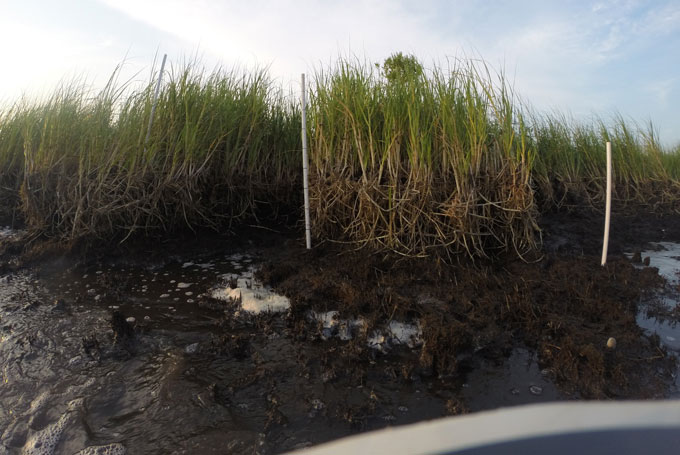Long after the Deepwater Horizon oil spill, the marshy shores of the Gulf of Mexico were still feeling the effects of the disaster. Marsh grass retained plant-smothering oil, and the soil continued to crumble away at a faster rate than before the spill, causing the shoreline to retreat more rapidly than it would otherwise, a new study shows.
Following an explosion in April 2010, the Deepwater Horizon rig pumped nearly 800 million liters of oil into the sea (SN: 2/12/20). The disaster killed dozens of humans and untold sea life. And the oil and its by-products were catastrophic for the Gulf ecosystem, both underwater and along the shore (SN: 4/3/15).
But the oil also caused structural damage to the shoreline by killing the marsh plants crucial to holding soil in place, researchers report January 25 in Environmental Pollution. That’s making the coast more vulnerable to tropical storms that may be increasing in intensity due to climate change.
“If the plants are compromised in any way, shape or form, you’re going to lose a lot of land,” says Giovanna McClenachan, an ecologist at Nicholls State University in Thibodaux, La.
McClenachan was working on her Ph.D. at Louisiana State University in Baton Rouge when the disaster happened. She and her supervisor, coastal ecologist Eugene Turner quickly set up research plots in the marshy coast of south Louisiana. Three times a year for the next eight years, they conducted tests on the soil strength with a sheer vane, a common tool farmers use to test soil strength, and analyzed the amount of oil it contained.
They also examined satellite images from 1998 to 2021 to analyze what marsh vegetation looked like before, during and after the spill over a much longer 23-year period.
The field test revealed that, immediately after the Deepwater Horizon disaster, the oil concentration of some of the most volatile components of oil, called aromatics, in marsh soil jumped from an average of 23.9 nanograms per gram of sediment before the spill to 17,152 nanograms per gram of sediment in 2011. By 2018, average levels had dropped to 247 nanograms per gram of sediment — but were still more than 10 times higher than before the spill.

Soil strength also declined by half after the spill. Before the spill, the average strength of the top 30 centimeters of soil was 26.9 kilopascals, which measures pressure in physics. The soil strength dropped down to 11.5 kilopascals at a low point in 2011. While the strength then began to recover at a rate of 5 percent per year, it still wasn’t fully recovered by 2018, the last year of the field study, when it had climbed back to 16.4 kilopascals.
This is partly due to the strong storms that have come through in the years since the spill. McClenachan says the initial oil spill killed a lot of plants on what was then the marsh shore. Once those died, the soil retained by the marsh grass roots was loosened and washed away. But the oil remained in the water and got pushed farther into the marsh, where it killed more plants.
Subscribe to Science News
Get great science journalism, from the most trusted source, delivered to your doorstep.
“The soil strength hasn’t recovered because there is still oil in the marsh, and that’s causing these really strong erosion events during storms that weren’t occurring prior to the oil spill,” McClenachan says.
Analysis of the satellite images showed that marsh loss rate doubled after the spill. The shoreline along the study area was already receding at 0.8 meters on average per year before the spill due to a combination of natural shifting of the marsh levels and human-caused factors like sea level rise. But that loss increased to nearly 1.7 meters on average per year afterward, although in the 12 months after Hurricane Isaac struck Louisiana in 2012, the marsh receded roughly 2.5 meters.
Some research has questioned whether it’s the oil spill affecting shoreline erosion rather than storms over the past decade. But Hurricane Katrina, which slammed into the Louisiana coast in 2005, years before the oil spill, did not cause nearly the same level of shore loss as much weaker storms after the oil spill, McClenachan’s satellite analysis shows. That suggests it’s not an either/or question; rather the enduring effects of the oil spill made the shoreline more vulnerable to storm damage.
The new study is unique in that it also shows the spill’s effect on the stability of the soil itself, says Scott Zengel, an environmental scientist with Research Planning Inc., a private research consultancy in Tallahassee, Fla., that often analyzes the impacts of the Deepwater Horizon disaster.
“It substantiates the idea that there really was an erosion effect,” he says, adding that the length of the study complements previous research showing oil has played a role in changes to the marsh.
These changes can be mitigated to some extent. Zengel’s work shows that techniques like replanting marsh grass can help decrease the rate of shoreline erosion. For boosting soil retention, he says, “it really points at the plants as being one of the key factors.”
